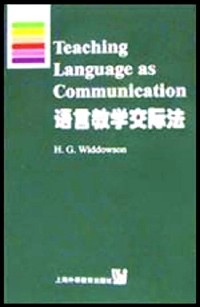
微信扫一扫,移动浏览光盘
简介
H.G.Widdowson has played an important and pioneering role in the development of communicative language teaching theory. This book develops a rational approach to the teaching of language as communication based on a careful consideration of the nature of language and of the language user's activities. It provides a lucid guide through a subject which is often confused and misrepresented, while providing a stimulus to all language teachers to investigate the ideas that inform their own practices. .
H. G Widdowson is Professor of English for Speakers of Other Languages at the University of London Institute of Education. ...
目录
introduction
chapter i usage and use
1.2 correctness and appropriacy
1.2 usage and use as aspects of performance
1.3 usage and use in classroom presentation
1.4 aspects of meaning: signification and value
1.5 usage and use in the design of language teaching materials
1.6 selecting areas of use for teaching language
1.7 summary and conclusion
notes and references
chapter 2 discourse
2.1 sentence, proposition and illocutionary act
2.2 cohesion and propositional development
2.3 coherence and illocutionary development
2.4 the relationship between propositional and illocutionary
development
2.5 procedures of interpretation
2.6 deriving discourse from sentences: an example
2.6.1 propositional development: achieving cohesion
2.6.2 illocutionary development: achieving coherence
. 2.7 conventions of coherence
2.8 deriving discourse by arrangement: another example
2.9 summary and conclusion
notes and references
chapter 3 linguistic skills and communicative abilities
3.1 the four skills
3.2 activities associated with spoken language
3.3 activities associated with written language
3.4 reciprocal and non-reciprocal activities
3.5 linguistic skills and communicative abilities
3.6 retrospective and prospective interpretation
3.7 assimilation and discrimination
3.8 non-verbal communication
3.9 summary and conclusion
notes and references
chapter 4 comprehending and reading
4.1 preview
4.2 the reading passage as dependent exemplification
4.3 the reading passage as independent 'comprehension piece'
4.3.1 extracts: the problem of authenticity
4.3.2 extracts: the comprehending problem
4.3.2.1 priming glossaries
4.3.2.2 prompting glossaries
4.3.3 simplified versions
4.3.4 simple accounts
4.4 gradual approximation
4.5 comprehension questions: forms and functions
4.5.1 types of question by reference to form
4.5.2 types of question by reference to function
4.5.2.1 usage reference
4.5.2.2 use inference
4.6 other reading exercises
notes and references
chapter 5 composing and writing
5.1 preview
5.2 types of grammar exercise
5.3 exercises in usage and use
5.3.1 composing sentences in passages
5-3.2 using the contexts of the reading passage
5.4 preparation exercises
5.5 exploitation exercises
5.5.1 gradual approximation: sentence to discourse units
5.5.2 gradual approximation: act to discourse units
5.5.2.1 focus on single illocutionary acts
5.5.2.2 relationships between pairs of acts
5.5-2.3 extension to larger discourse units
5.5.3 rhetorical transformation of discourse units
5.5.4 information transfer
5.6 summary and conclusion
notes and references
chapter 6 towards an integrated approach
6.1 preview: the need for integration
6.2 the discourse to discourse scheme
6.3 types of procedure
6.3.1 demonstration: rhetorical transformation by gradual
approximation
6.3.2 demonstration: rhetorical transformation by
illocutionary change
6.3.3 demonstration: information transfer
6.4 principles of approach
6.4.1 rational appeal: the use of translation
6.4.2 integration and control
6.5 summary and conclusion
notes and references
index
chapter i usage and use
1.2 correctness and appropriacy
1.2 usage and use as aspects of performance
1.3 usage and use in classroom presentation
1.4 aspects of meaning: signification and value
1.5 usage and use in the design of language teaching materials
1.6 selecting areas of use for teaching language
1.7 summary and conclusion
notes and references
chapter 2 discourse
2.1 sentence, proposition and illocutionary act
2.2 cohesion and propositional development
2.3 coherence and illocutionary development
2.4 the relationship between propositional and illocutionary
development
2.5 procedures of interpretation
2.6 deriving discourse from sentences: an example
2.6.1 propositional development: achieving cohesion
2.6.2 illocutionary development: achieving coherence
. 2.7 conventions of coherence
2.8 deriving discourse by arrangement: another example
2.9 summary and conclusion
notes and references
chapter 3 linguistic skills and communicative abilities
3.1 the four skills
3.2 activities associated with spoken language
3.3 activities associated with written language
3.4 reciprocal and non-reciprocal activities
3.5 linguistic skills and communicative abilities
3.6 retrospective and prospective interpretation
3.7 assimilation and discrimination
3.8 non-verbal communication
3.9 summary and conclusion
notes and references
chapter 4 comprehending and reading
4.1 preview
4.2 the reading passage as dependent exemplification
4.3 the reading passage as independent 'comprehension piece'
4.3.1 extracts: the problem of authenticity
4.3.2 extracts: the comprehending problem
4.3.2.1 priming glossaries
4.3.2.2 prompting glossaries
4.3.3 simplified versions
4.3.4 simple accounts
4.4 gradual approximation
4.5 comprehension questions: forms and functions
4.5.1 types of question by reference to form
4.5.2 types of question by reference to function
4.5.2.1 usage reference
4.5.2.2 use inference
4.6 other reading exercises
notes and references
chapter 5 composing and writing
5.1 preview
5.2 types of grammar exercise
5.3 exercises in usage and use
5.3.1 composing sentences in passages
5-3.2 using the contexts of the reading passage
5.4 preparation exercises
5.5 exploitation exercises
5.5.1 gradual approximation: sentence to discourse units
5.5.2 gradual approximation: act to discourse units
5.5.2.1 focus on single illocutionary acts
5.5.2.2 relationships between pairs of acts
5.5-2.3 extension to larger discourse units
5.5.3 rhetorical transformation of discourse units
5.5.4 information transfer
5.6 summary and conclusion
notes and references
chapter 6 towards an integrated approach
6.1 preview: the need for integration
6.2 the discourse to discourse scheme
6.3 types of procedure
6.3.1 demonstration: rhetorical transformation by gradual
approximation
6.3.2 demonstration: rhetorical transformation by
illocutionary change
6.3.3 demonstration: information transfer
6.4 principles of approach
6.4.1 rational appeal: the use of translation
6.4.2 integration and control
6.5 summary and conclusion
notes and references
index
Teaching language as communication
- 名称
- 类型
- 大小
光盘服务联系方式: 020-38250260 客服QQ:4006604884
云图客服:
用户发送的提问,这种方式就需要有位在线客服来回答用户的问题,这种 就属于对话式的,问题是这种提问是否需要用户登录才能提问
Video Player
×
Audio Player
×
pdf Player
×


